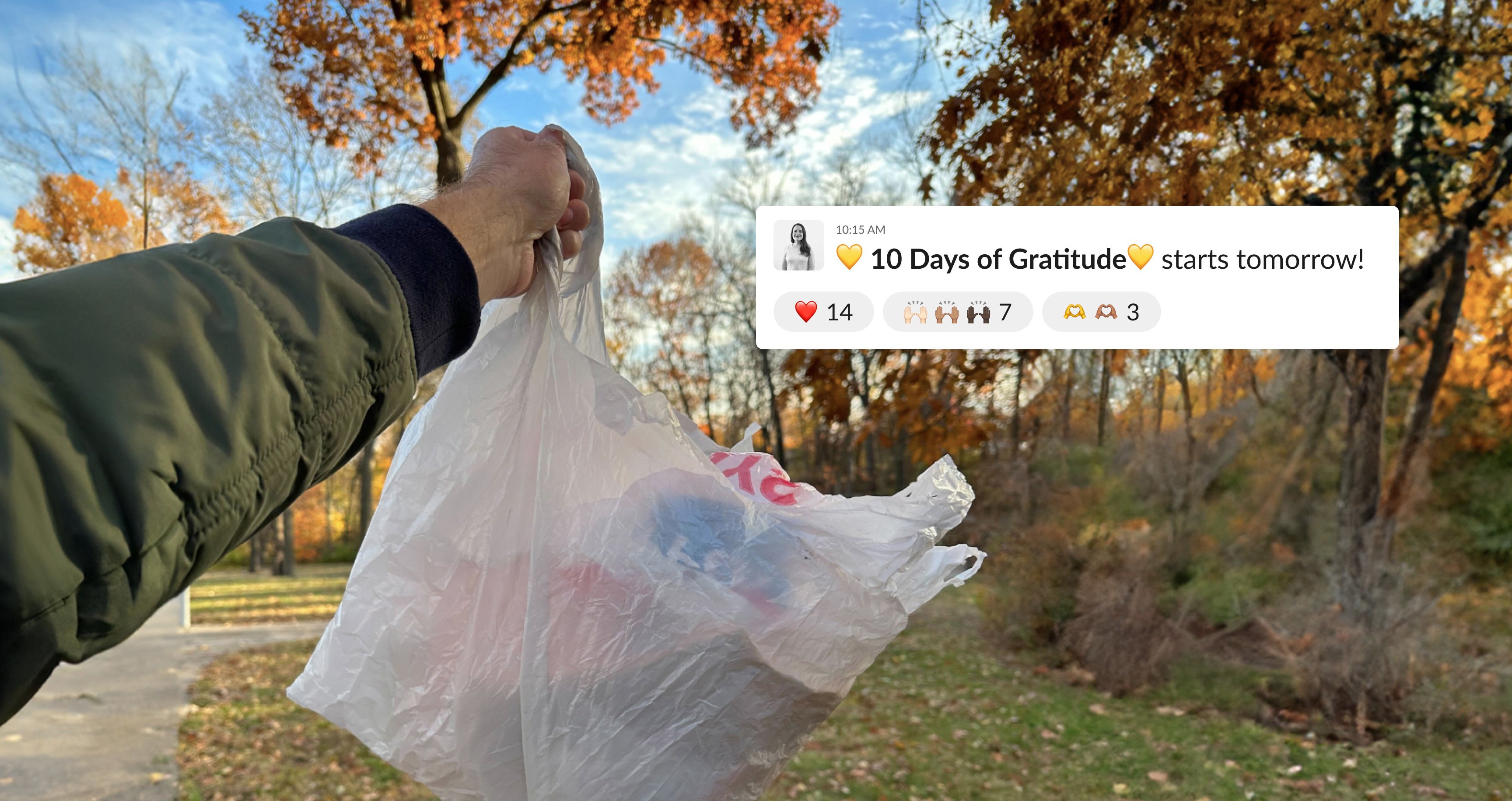

At Blink, we believe authenticity is fundamental to well-being and that bringing our authentic selves to work is better for our employees, business, and, ultimately, the world.
Research from positive psychology emphasizes that practicing gratitude is key to well-being. During the difficult days of the pandemic, we looked for additional ways to support employees in this way and began our annual 10 Days of Gratitude Challenge.
What is the 10 Days of Gratitude Challenge?
10 Days of Gratitude is a challenge with daily prompts encouraging employees to give back to their local communities. For the last three years, during the holiday season, Blinkers have extended themselves beyond work and into their communities, whether donating to their local blood bank, volunteering in their communities, or supporting BIPOC businesses.
“What inspired me the most about this challenge was the simplicity of each prompt that reminded me of often overlooked acts of kindness and the sense of community created by sharing charitable interests and causes with co-workers that opened my eyes and inspired me to learn more.” —Jacob Phillips, Marketing Director
How it works
Step 1: Pick ten consecutive days to host your challenge. We start ours the second week of November, so it ends right before our annual Thanksgiving — aka Blinksgiving — potluck.
Step 2: Choose your prompts (one for each day). Here are some ideas to get you started:
- Donate to an organization you care about ($5 min)
- Donate blood or contribute to a blood bank ($5 min)
- Volunteer your time
- Clean up litter in your neighborhood or local park (at least 10 minutes)
- Leave a box of goodies in the mailbox for your mail carrier
- Run an errand for a family member or friend who is busy
- Send a thank you card for those who you are grateful for and tell them why
- Support a BIPOC-owned business
Step 3: Ask employees to show their participation by sharing in a public work channel (i.e., Slack or Teams.) Sharing publicly encourages others to join and raises awareness for the organizations and activities people support.
Step 4: Add employees to the raffle each time they participate; the more they participate, the more chances they have to win a wellness-related prize and the opportunity to donate to an organization of their choice.
10 Days of Gratitude is designed to benefit Blinkers and their communities. The more employees who participate, the more chances they have to win. That said, I believe the sense of community and shared effort truly motivates Blinkers to join in.
Step 5: Encourage employees to participate every day, even if they can’t commit to an act of gratitude. We love seeing catch-up posts or even Blinkers involving their family members.
Step 6: Send encouragement along the way! Share routine updates on the progress you’re making together as a community.
Step 7: Tally up the results. At the end of your 10 Days of Gratitude challenge, use a spreadsheet to review your participant data — we are, after all, an evidence-driven design firm, so we love to see the data.
# individual participants
# repeat participants
# organizations donated to
# blood donations + monetary contributions
# BIPOC businesses supported
# acts of service + kindness
# food + clothing donations
# words of gratitude
Step 8: Announce your results. We like to announce our final participation results to the company during our Monday Morning Staff Meeting.
Step 9: Raffle time! Every time employees participate in 10 Days of Gratitude, their name gets added to the raffle. Once we have our results, we add all participants to the virtual raffle. Pro-tip: Use wheelofnames.com for a fun, interactive experience for your employees.
Step 10: Celebrate your winners and participants!
Gratitude in the workplace
Blink’s Chief Culture Officer Linda Wagener, Ph.D., shares why practicing gratitude should be a best practice for businesses.
With gratitude, people acknowledge the goodness in their lives and usually recognize that the source of that goodness lies at least partially outside themselves. As a result, being grateful helps people connect to something larger than themselves — whether to other people, nature, or a higher power.
Research shows that consciously practicing gratitude can reduce feelings of stress and anxiety. In fact, studies have found that a single act of thoughtful gratitude produces an immediate 10% increase in happiness and a 35% reduction in depressive symptoms.
Benefits of expressing gratitude in our day-to-day lives:
- Better sleep
- Improved health
- Deeper relationships
- Enhances empathy
- Decreases aggression
- Increases mental health
Not to mention the added benefits of expressing gratitude in the workplace:
- More trusting
- More likely to help each other out
- Enhanced self-worth and self-efficacy
- Increased life satisfaction and resilience to stress
Other ways to incorporate your gratitude practice at work
While practicing gratitude as a team is encouraging, you don’t have to wait for your company to start a challenge for yourself. Practicing gratitude year-round is good for our well-being, families, and communities.
- Create a High5s channel in Slack and encourage staff to celebrate their teammates’ good work and accomplishments.
- Host a random act of kindness day with a list of suggested actions.
- Start monthly team meetings with a gratitude segment.
- Write down three things you're grateful for at the top of your to-do list.
- Tell your colleagues, friends, and family why you appreciate them!
A continuous practice of gratitude
Each year, I’m blown away by the generosity of fellow Blinkers — especially during the end-of-year crunch when time becomes a precious commodity. In 2023, we exceeded our goal of 200 acts of gratitude despite work deadlines and busy social calendars.
10 Days of Gratitude at Blink is not just a yearly tradition; it reflects our core belief in the power of gratitude. We've seen its positive impact on our employees' well-being, workplace culture, and communities. As we continue practicing gratitude year-round, we hope this initiative inspires others to embrace gratitude in their lives and workplaces. By acknowledging the good around us, we can create a brighter, more compassionate world for everyone, whether it's through organized challenges like ours or simple acts of gratitude in our day-to-day lives.



